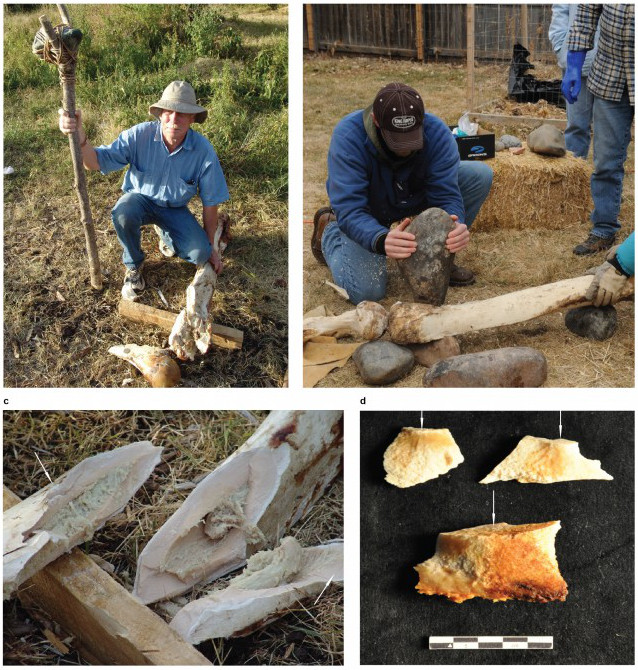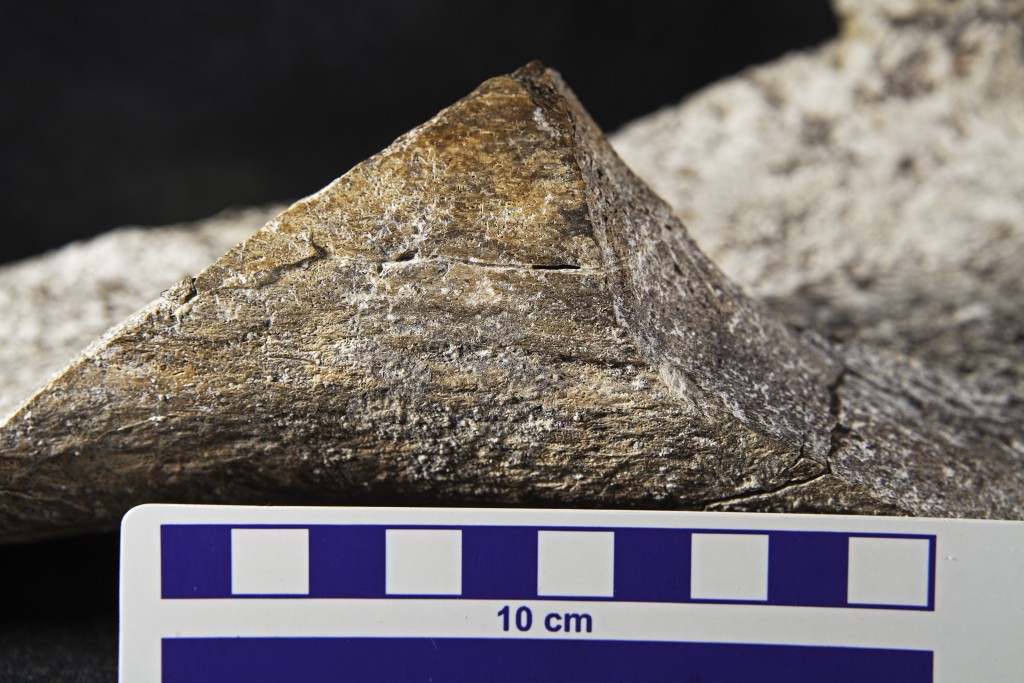In a study that’s already attracting considerable controversy, a research team says it has found evidence of human habitation along the southern coast of California dating back an astounding 130,000 years. That’s 10 times older than most estimates, and a complete upending of what we thought we knew about how and when humans first arrived in North America — if it turns out to be true.
The surface of mastodon bone showing half impact notch on a segment of femur. (Credit: Tom Deméré, San Diego Natural History Museum)
Most archaeologists and palaeontologists believe that North America’s first occupants arrived on the continent sometime between 12,000 to 15,000 years ago. Some suspect it may have occurred as far back as 24,000 years ago, but that remains controversial. So imagine the surprise of scientists to learn of a new study published in Nature claiming that evidence has been found showing human activity on the continent 130,000 years ago. That isn’t just a mild revision of conventional thinking, it’s a total rewrite.
Not everyone is buying it. Many of the outside experts Gizmodo spoke to were highly critical of the study, saying it isn’t an open-and-shut case as the researchers are making it out to be. The authors of the new study, fully aware of the storm they’re about to unleash, are prepared to take on their critics.
“Extraordinary claims require extraordinary evidence,” said Thomas Deméré, curator of palaeontology at the San Diego Natural History Museum and the new paper’s corresponding author, during his opening remarks at a press conference held earlier this week. It was an audacious start to the meeting given that the reporters in attendance, myself included, were ready to pounce with the exact same expression of incredulity.
That “extraordinary evidence,” said Deméré, was actually discovered in the early 1990s by San Diego Natural History Museum palaeontologists while excavating the Late Pleistocene Cerutti Mastodon site in coastal San Diego County, California. Attempts to accurately identify and date the objects found at the site were unsuccessful until now, the researchers said.

Specifically, the site contained the sharply broken bones, tusks and molars of a lone mastodon (Mammut americanum), which the researchers say were buried in fine-grained sediments alongside stone hammers and anvils. Analysis by Deméré and his colleagues suggest the mastodon remains were modified by early humans, who were likely making tools from the bone and extracting the precious marrow. Using a technique known as uranium-thorium dating, numerous specimens recovered from the site were found to be 130,000 years old, with a margin of error around 9300 years. No human remains were found at the site, or other artefacts suggestive of human habitation.

Breakage patterns resulting from hammerstone strikes. (Credit: Kate Johnson, San Diego Natural History Museum)
In terms of the evidence of human alteration, the researchers pointed to numerous limb bone fragments with apparent spinal fractures. The bones, which featured impact notches and cone marks, appear to have been broken while they were still fresh. Several of the mastodon’s bone and molar fragments look as though they were struck with hard objects, and the five large hammerstones and anvils uncovered at the site show signs of use and wear. Based on how the items were distributed at the site, the researchers say it was a likely a space where the mastodon was processed.
Steven Holen, curator of archaeology at the Denver Museum of Nature and Science, and a co-author of the new paper, says the site was in pristine condition, and that the objects found at the site were not disturbed by geological processes. To show that the mastodon bones were modified by humans, Holen conducted two field experiments in which he smashed the bones of dead elephants with rockhammers and anvils.

Bone breakage experiments on a modern elephant’s leg bones in an attempt to determine the kinds of breakage patterns resulting from hammerstone hits. (Credit: Kate Johnson, San Diego Natural History Museum)
“We came up with the same types of fracture patterns,” he said at the press conference. Holen also compared the fractures to bones found at similar archaeological sites in Kansas and Nebraska, once again finding similar patterns. “We can eliminate natural [geological] processes that breaks bone like this, including other [carnivorous] animals,” he said. The researchers said that this particular bone-smashing technique was first developed in Africa well over a million years ago.
Team member Richard Fullagar, an expert in stone artefacts at the Centre for Archaeological Science at the University of Wollongong, analysed the stones present at the site, looking for signs that they were used by humans. “These were tools used for smashing up bones,” he said, “What’s unique about this site is you can identify both hammers and anvil stones used for the processing of an animal, which is quite rare.” In addition to extracting marrow from the bones, the researchers believe these early humans likely used mastodon bones to make tools, such as Acheulian hand axes.

A spirally fractured mastodon femur bone. (Credit: Tom Deméré, San Diego Natural History Museum)
To date the objects, the researchers recruited James Pace, a research geologist with the US Geological Survey. He used a technique known as uranium-thorium dating, considered a reliable method for dating ancient stones and bones, to analyse nearly a hundred objects found at the site, all of which dated back approximately 131,000 years.
“The distributions of natural uranium and its decay products both within and among these bone specimens show remarkably reliable behaviour, allowing us to derive an age that is well within the wheelhouse of the dating system,” he explained. “[We have established a] robust, defensible age for human habitation in North America.”

Artist’s depiction of Clovis humans hunting mastodon in North America some 15,000 years ago. (Illustration by Velizar Simeonovski © The Field Museum)
As for who these early humans were, how they got to California, and what became of them, the researchers could only speculate. An intriguing aspect of this study is that many of the pieces required for this early human migration to North America may have been in place at the time. Evidence presented in Nature last year suggested that Neanderthals lived in Siberia around 100,000 years ago in the Altai Mountains, and a 2015 Nature study showed that modern humans lived in Asia around the same time. These early humans may have taken advantage of low sea levels, trekking across the Beringia land bridge, or by taking watercraft, into North America.
Once on the continent, they could have migrated along the west coast into what is modern day California.
Barring the discovery of actual human remains, however, we may never know the whole story.
“We don’t know who they were,” said Fullagar, “and we have no idea of their relationship to later humans who lived in North America. Unfortunately, we don’t have human remains from the site, so we don’t have genetic evidence to look at that relationship. They could have very well become extinct. There are so many unknowns about this we can’t give a clear answer.” To which Holen elaborated: “It’s quite possible that early populations came in and didn’t make it… it’s a distinct possibility.”
Regardless, it’s a dramatic retelling of human history. Accordingly, Gizmodo reached out to numerous experts for their take on the paper, many of whom declined to comment. Of the responses we did receive, most were sceptical. Experts seemed to think that the uranium dating technique was valid, but that the archaeological interpretations were questionable.
“In my opinion this research comes nowhere close to supporting the case that the discovered specimens were humanly manufactured,” archaeologist Eren Metin, the director of the Eren Laboratory for Prehistoric and Experimental Archaeology at Kent State University, told Gizmodo. “The problem is that the authors did not show that the artifacts were not the result of geological or other non-human processes (e.g. animal trampling). This is what they would have needed to do to support their case.”
Frederic Sellet from the University of Kansas, an archaeologist who studies the first Americans, says the evidence presented in the Nature study is not without problems. “Both the chronological context and the signs of human activity at the site can be questioned,” he told Gizmodo. “Extraordinary claims require extraordinary evidence. What I have seen falls short of this measure. If Holen and his colleagues are correct, we are missing 100,000 years of archaeological record, not just in North America, but also in Siberia. I doubt that this is the case, simply because we have been avidly searching for these early sites for a long time.”
“In short, I question Nature‘s decision to publish this article,” Sellet continued. “It is bound to grab everyone’s imagination, but the conclusions are not supported by other lines of evidence such as other archaeological sites or current genetic studies.”
“The site in this Nature paper definitely needs more research and much more thorough study methods,” said anthropologist Gary Haynes of the University of Nevada, Reno. “The bones and stones lying close together and the complete lack of recognisable lithics [stone tools] or hearths which are typical of human presence everywhere else in the world at sites even a million years old sure does raise questions about whether this find was made by humans or some form of ancestral hominin.”
“I actually reviewed the paper,” said Rainer Grün, a scientist at the Australian Research Centre for Human Evolution. “I think that the dating is sound… it was done with conventional, well established U-series methodology. All samples had results that agreed with each other and there were no signs of leaching, a process that could lead to age overestimations. However, I cannot judge the argument that the marks on the bones were made by humans. The paper was reviewed by three archaeologists who were all convinced by the evidence.”
Radiocarbon dating expert Katerina Douka from the School of Archaeology at the University of Oxford told Gizmodo she was “astonished” by the results. “If they hold true, it means that there were more than one and certainly a much earlier exodus of modern humans out of Africa into Asia and then into America,” she said. “This may be a failed colonization event we hadn’t previously recognised and it is — and I repeat, if it holds true — yet another proof of how ingenious and capable our species is.”
At the press conference, the researchers said they’re ready for the backlash. “People will be deeply sceptical,” said Holen, “and we’re expecting this scepticism due to the extremely old age of the site. But if they look at our article… and look at the distribution of fractured bones around the anvils, and the usage patterns, they will see we have provided conclusive evidence. I think we’ve made a very good case.”
At the conclusion of the meeting, the researchers said they’d like to invite other scholars to examine their evidence for themselves, to seek out older evidence in search of similar wear marks on stone tools, and to be on the search for older age deposits. As for the Cerutti site itself, it’s now in an urban area of San Diego next to State Route 54 — in fact, the site was discovered during the construction of this freeway. Regrettably, most of the site has been bulldozed, but the possibility of further investigation still exists. “We’ve been talking about going back to the site [as we feel the] bone-bearing bed may still be preserved, but we don’t have concrete plans,” said Holen, “It’s a possibility.”
Given the claim of this new paper, a return to the site would seem essential. Until more “extraordinary evidence” is found, the idea that humans were present in North America so long ago will forever remain hotly contested.
[Nature]
